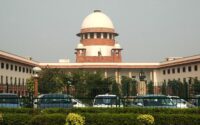JUDICIAL ACTIVISM AND JUDICIAL RESTRAIN
The term “Judicial activism” refers to judicial rulings suspected of being based on personal or political considerations rather than on existing law. The actual connotation of the term ‘judicial activism’ is still a mystery. But it essentially implies an essential role that the judiciary plays in the promotion of justice. The Black’s Law Dictionary defines judicial activism as a “philosophy of judicial decision making whereby judges allow their personal views about public policy, among other factors, to guide their decisions.” It emphasises on the rights entrusted to the jurists to strike down any law or rule that goes against the spirit of the Constitution. In its positive sense it connotes a check on the tyranny of the Executive and as a ‘damage control’ tool when the Executive fails to recognize its duty properly and when intervention is essentially required.
The origin and evolution of judicial activism can be studied under two theories i.e. “The theory of vacuum filling” and “The theory of social want”. Also, the concept of judicial activism has its roots in the English concepts of ‘equity’ and ‘natural rights’ and the first landmark case in this regard was the case of Marbury v. Madison[1]wherein for the first time, the judiciary took an active step and took steps above the legislative actions.
‘Judicial Activism’ and ‘Judicial Restrain’ are the terms commonly used to describe the assertiveness of judicial power. These terms are often employed non-committally i.e. merely as descriptive short hand to identify some court or judges as more activist or more restrained than others. In this sense, the usage is neither commendatory nor condemnatory. The terms are used from the angle of the personal or professional view of the ‘right role’ of the Court. The framework of judicial activism is much wider in India because of the unique position given to the judiciary especially to the Supreme Court, under the Constitutional scheme. The Supreme Court is at once, the arbiter of federal principle, the guardian of fundamental rights of the citizens, final interpreter of the constitutional and other organic laws and last but not the least the final judge to determine the validity of even a constitutional amendment. Therefore in India, the judiciary, mainly the Supreme Court and the 24 High Court‘s have a greater scope to be active while discharging various judicial functions.
Also, it is evidently opined that a responsible government is the hallmark of a successful democracy and constitutionalism, its collapse warrants many a drastic and unconventional steps and when the legislature fails to make the necessary legislation to suit the changing times and when the governmental agencies fail miserably to perform their administrative functions sincerely, it would lead to erosion in confidence in the constitution and democracy among the citizens. In such an extraordinary scenario the judiciary may legitimately step into the areas usually earmarked for the legislature and executive and the result is the judicial legislation and government by judiciary which essentially show the role “judicial activism” has to play. Interestingly, it is emphatically stated that there should exist a judicial enthusiasm to participate in bringing about a social reform and a change at large. The people involved in interpreting and applying a law which is not static but dynamic cannot sit as idle and silent spectators when the times go on changing and with the need of the hour the judiciary has encouraged social reformative changes and at times initiated Public Interest Litigation (PIL), also known as Social Action Litigation (SAL) in India. In such cases, the courts have discarded the traditional constraints on themselves such as the requirements of standing, ripeness of the case and adversarial forms of litigation and have assumed the functions of an investigator, counsellor, and monitor of administration.
Additionally, the fundamental law of the land i.e. the Constitution of India, 1950 has designated the higher judiciary in India as the guardian of the fundamental rights of the citizens. A cumulative reading of Articles 13, 32 and 226 makes it very clear that the higher judiciary in India has been endowed with the onerous task of upholding the fundamental rights of the citizens. Under Article 13 of the Constitution any law which abridges fundamental rights shall be declared as void by the Supreme Court and the 18 High Courts. Under Article 32 of the Constitution, the Supreme Court has the power to issue any writ, order or direction to any person or authority violating the fundamental rights of citizens. In fact the right to approach the Supreme Court itself has been made a fundamental right on its own under Articles 32 to 35. Under Article 226 of the Constitution, the High Courts’ enjoy a power which is even more widely, to enforce the fundamental or other rights of the citizens, by invoking the writ jurisdiction of the High Court. All these powers vested in the Constitutional Courts, enable them to exercise vast powers of judicial review in respect of any legislative, quasi-legislative, executive, quasi-judicial or other actions of the State and its agencies. In fact this is the role which has been played by the Supreme Court and the High Courts’ effectively. The result often is the brooding omnipresence of judicial activism.
It is thus clear that there has been instances of beneficial judicial activism to a great extent but it cannot be disputed that judicial activism has done a lot to ameliorate the conditions of the masses. It has evidently set right a number of wrongs committed by the States as well as the individuals. The greatest asset and the strongest weapon in the armoury of the judiciary is the confidence it commands and the faith it inspires in the minds of the people in its capacity to do even-handed justice and keep the scales in balance in any dispute.
[1] 5 U.S (1 Cranch) 137 (1803).
By
Ritum Kumar


